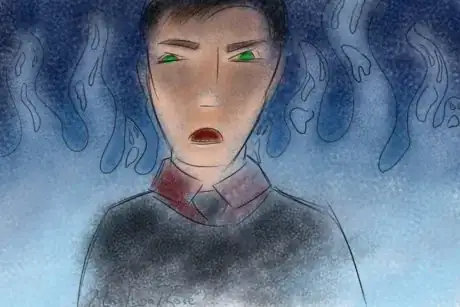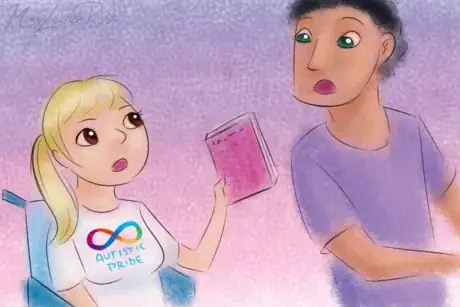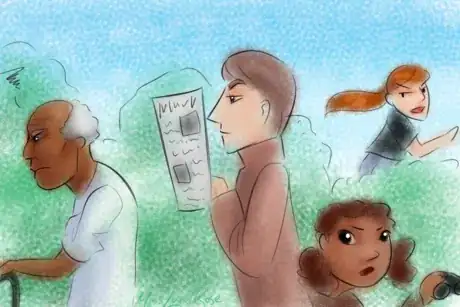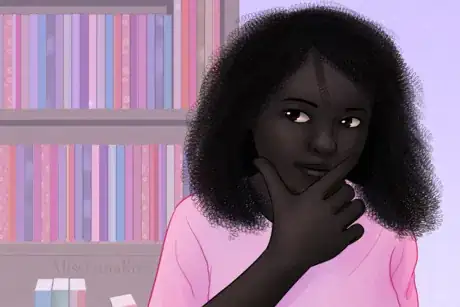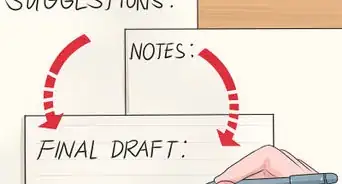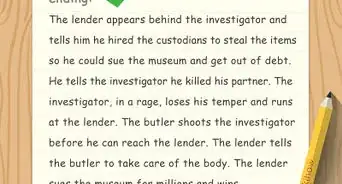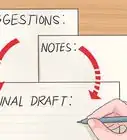X
wikiHow is a “wiki,” similar to Wikipedia, which means that many of our articles are co-written by multiple authors. To create this article, volunteer authors worked to edit and improve it over time.
This article has been viewed 28,567 times.
Learn more...
Horror-love stories are a unique blend of both creepy and romantic themes. This type of story combines the malevolence of horror tales and the warmth of love stories. Although they can be difficult to write, they are one of the most interesting types of work to read. Follow this article to write your own combination of these literary classics.
Steps
Part 1
Part 1 of 3:
Gathering Inspiration
-
1Use your surroundings to inspire the setting of your story. Since the theme of your story combines love and horror, visit romantic areas and creepy places that give you chills. As you walk around, keep a notebook with you and jot down short descriptions of scenery to describe your story's location. Later, you can combine them together when you begin to write.
- Be creative when describing your story's setting. Fusing together different locations is no easy task, but your imagination can help bring your fictional world to life. Don't hesitate to add fictional places, even if the locations you visited don't contain them.
-
2Use people's experiences and opinions. Ask them what they find romantic and horrifying, as well as their thoughts on a perfect date. Gather inspiration from their thoughts and memories to add ideas to your story. Take notes so you don't forget.Advertisement
-
3Find inspiration from your own feelings. Consider what you would want from a partner. Think about ideal personality traits, such as the willingness to be considerate or the ability to listen well. Since everyone has different preferences, you can use your own ideas and other people's thoughts to support your story.
-
4Read other romance and horror stories. Include both good and bad books in your reading list, because you can learn what looks best and what doesn't. Draw inspiration from a variety of authors. Doing this will teach you to use both genres well while finding a way to stand out.
- Cheap paperback romance stories have worth. They tell you what people want out of a romance. However, be careful when reading these, as some may glorify abusive relationships.
- Read authors who give stylistic influence. If you like detailed description, read from writers like Steinbeck. O'Connor, and Faulkner. Then, read Hemingway just for contrast. Find people who do it well, and learn from them.
Advertisement
Part 2
Part 2 of 3:
Planning Your Story
-
1Choose your main characters. Create an outline of their appearances and personalities, as well as a history of their past and any major experiences that influence their present lives. In order to allow each one to stand out, give them different quirks and habits that obviously set them apart from one another. Be sure that each character contributes to the plot and relationship.
- Give your characters unique names. While you should avoid overly strange or difficult-to-pronounce ones, it's good to have names that stand out and capture your readers' attention. For example, a name like "Kellen" would stand out better than "Mark."
- Set up goals for the characters. In order to show readers that they have a purpose in the story, give them an objective that they'll work to achieve throughout the entire book. For suspense, add a consequence of not meeting that goal.
- As you figure out your story, your characters' personalities can be tailored to the needs of the plot.
-
2Create detailed personalities to make the romance work. Love is driven by more than physical appeal—each character adds something important to the relationship. You can make your characters appealing by creating nuanced personalities. Plan out their strengths, vulnerabilities, and histories.
- Take the time to understand your characters. When writing an outline and filling in their information, include small details that make them stand out. Although you might not include them in a story, being able to see them as unique people is important when writing as realistically as possible. If your enthusiasm and love for them bleeds into your story, readers will be able to feel the emotions and emphasize with them.
- One good way to understand your characters better is to write down their backstories and motivations on a separate sheet of paper.
- Skills should be balanced between characters. In order to have working relationship, their abilities must complement each other. Perhaps the man has the charisma and bravery while the woman has the brains to form strategies against the villain. By showing that they need each other, readers will be able to emphasize with them and enjoy their relationship.
-
3Plan your antagonist. To add suspense to the story, create an opposing force that strives to prevent the characters from reaching their goals. Who or what is fighting these lovers, and why? What does the antagonist gain out of antagonizing your main characters? Consider introducing the horror aspect through the enemy, using their actions and plans to bring suspense into the novel. Several examples include:
- The homophobic pastor is motivated by hatred of lesbians. He draws upon supernatural forces to fight the lovers, believing that they are God's angels. In reality, they are from Hell.
- The heroine is a witch, and a pair of witch-hunters are after her. The hero wants to protect her.
- After getting lost in the woods, two lovers are stalked by a frightening beast.
-
4Create initial encounters. Uncertainty is an important aspect of horror. Therefore, give your readers brief glimpses of the antagonist to cause suspense and mystery. At first, your main characters should have no idea what they're up against. As the story continues, drop hints and pieces of the puzzle. Leave the readers wondering what terrifying monster the couple is facing. Initial encounters could include:
- Threatening messages scrawled on walls
- Rocks thrown through the window with ominous notes attached
- An attack from a huge creature at night
- Strange letters and/or packages in the mail
-
5Avoid stereotyping your villains as marginalized people. Most readers will immediately peg the mentally ill, disabled, religious minority, etc. character as the villain. With your suspense lost, the story will become dull since your readers have figured out the identity of your antagonist. It also hurts people who belong to those minority groups since it reinforces prejudices against them. It will alienate them as readers. Instead, try casting marginalized people as heroes or helpful minor characters. Examples are:
- The hero is a handsome Latino man.
- The mentally ill librarian seems withdrawn and reclusive when questioned. But via email, she shares crucial information about supernatural occurrences in the town.
- The effeminate gay man leads them to a safe house and provides protection while they figure out what to do next.
-
6Consider leaving a red herring or two. It is a literary device used to mislead readers, causing them to make the wrong assumptions while being distracted from the truth. In order to cause more mystery and build up to the climax of your story, set up obvious suspects so that readers accuse the wrong person of being the enemy. The real antagonist will be working behind the scenes against the main characters, ready to complete his or her goal.
- For example, one of your characters could strongly voice his homophobic opinions, resulting in the readers believing that he is the threat. However, he could turn out to be a coward while the quiet pastor is the real enemy.
-
7Outline your general plot before you begin drafting. By creating a stable structure that includes the main points, you will have a solid sense of where your plot is going as you write. Give yourself a general sense of the beginning, the rising action, the climax, and the resolution. Be sure that the suspense grows throughout the plot until it finally reaches the point where the plot twist occurs or all the mysteries are explained.
- In order to drop appropriate hints, it is important to understand the enemy and their moves as their plan progresses.
Advertisement
Part 3
Part 3 of 3:
Writing the Story
-
1Plan a captivating beginning. A strong beginning captures the reader's interest and helps them care about the characters in the plot. It establishes the fictional world and the people in it, forming images in readers' heads so they are drawn into the book. However, it is important that you write a hook that grabs attention. Without a compelling opening line, readers will not have the patience to read through pages of information. In order to ensure that they continue reading, be sure that you capture their focus by including a unique, out-of-the-ordinary line.
- Writing a solid beginning can be tough. It's okay to write a sloppy first draft, or write a middle scene first, or do whatever works for you. Follow your inspiration. You can always refine later.
- Your first sentence is your hook. Brainstorm some different attention-grabbing first sentences, and keep them in your notebook.
-
2Keep your readers' interest. Once you have grabbed their attention with your opening line, it is your job to ensure that they keep reading. Introduce interesting scenes into the story, as well as some action to keep them on the edge of their seats. Not all readers will have the patience to wait until the plot becomes captivating. Therefore, it is best to continue providing them with interesting dialogue, unique descriptions, and compelling events. Here are some ways to make a reader feel invested:
- Show what motivates the characters. Why do things matter to them?
- Balance slow and fast parts. Don't let it stay slow for too long. After an intense scene, give readers a little space to breathe.
- Show ups and downs. Let the characters be happy sometimes, and frightened/sad/upset other times.
- Write what interests you. If you think a scene is boring, then the readers probably will think so too. Cut it out, or shorten and summarize it.
-
3Include dialogue. Long, endless paragraphs are a turn-off for many readers. Not every reader will have the patience to sort through giant chunks of information. Try to make dialogue power your story, rather than relying too much on narration.
- Show characters' personalities through the way they speak. For example, a more confident character might not be afraid to be talkative, while a quieter one may speak less.
- Break up a paragraph if it looks like it's getting too long.
-
4Begin considering titles. In order to give readers an idea of what book they're picking up, you should suggest both horror and love in the title. For the horror aspect, consider the scary motifs in your story, as well as the type of hints you drop. It can take a while to pick a title, so you can devote a notebook page to random ideas.
- Combine elements of warmth and fear. A Little Love Story doesn't sound like horror while The Destroyer doesn't suggest love. Nightmare at Rose Lane is an example that uses both.
- Realize that the book jacket will be there to help do the work. The title can be a strong hook, which will lead readers to look at the back cover for the summary.
- Many writers use working titles until they think of a good one. You can save your document as "Romance Persecution Story" or "Love Horror Story.docx."
-
5Find an alpha reader to read and talk about your story. An alpha reader is a trusted person who readers each chapter as you finish it. They can provide suggestions to improve your story, as well as encourage you to keep writing. Their job is to mainly provide support and give you motivation to write when you're slacking off. It is best to choose a trusted family member or a friend to be your alpha reader.
-
6Find an editor to edit your drafts. Find a patient family member or friend who will tear your piece apart and help you strengthen it. They can find your plot holes, point out grammatical errors or typos, and give you tips on fixing dilemmas. Accept their criticism, and understand that—no matter how harsh it may seem—it will help improve your story in the long run. Although you may not want to change parts of your writing, it is necessary to be flexible in order to ensure that readers will enjoy your work.
- Be prepared to handle criticism. A good critic will not only find grammatical errors but also point out major plot holes and problems. Be sure that you can listen to critiques without taking it personally.
- Expect to rewrite your story once or twice. Understand that your hard work will eventually build up to a great reward. Even professional authors must do this a few times before they finally get it right.
-
7Be patient with your work. Understand that writing a story takes time, and the first few drafts may not also be the best. Sometimes, you may face writer's block or lose the motivation to write. You might not always love your story, and you may sometimes consider giving up. However, the harder you work at your writing, the better you will become. Realize that the greatest rewards are often the hardest to achieve.
- Give yourself breaks. If you find that you have a hard time writing, you may need to take some time off. It is best to come back with a clear mind and fresh perspective.
Advertisement
Community Q&A
-
QuestionIs a girl going yandere for a boy a good idea?
 PhantasmagoriaCommunity AnswerIt depends on how you write it. Any idea can be good if you pull it off well. If you like what you're writing and have a good idea of how you want things to happen, it should be good. There's nothing wrong with your idea itself, and it could make a lovely story.
PhantasmagoriaCommunity AnswerIt depends on how you write it. Any idea can be good if you pull it off well. If you like what you're writing and have a good idea of how you want things to happen, it should be good. There's nothing wrong with your idea itself, and it could make a lovely story. -
QuestionIs a vampire love story a good idea?
 Tom De BackerTop AnswererOf course! It's been done countless times before, but so has most every other idea in existence. Perhaps think of a new twist, or write a particularly well-crafted scene, but whatever you feel like writing, that's what you should write.
Tom De BackerTop AnswererOf course! It's been done countless times before, but so has most every other idea in existence. Perhaps think of a new twist, or write a particularly well-crafted scene, but whatever you feel like writing, that's what you should write. -
QuestionWhat should I name a romantic horror story?
 ToniAjoneenCommunity AnswerIt depends on what your main plot is. Look at Stephanie Myers' Twilight for example, she most likely chose the name Twilight since the majority of characters are nocturnal creatures (creatures that walk around at night). The title is completely up to the writer but still able to be relevant to the storyline in some way.
ToniAjoneenCommunity AnswerIt depends on what your main plot is. Look at Stephanie Myers' Twilight for example, she most likely chose the name Twilight since the majority of characters are nocturnal creatures (creatures that walk around at night). The title is completely up to the writer but still able to be relevant to the storyline in some way.
Advertisement
Warnings
- Don't go overboard on stylistic devices in one paragraph.⧼thumbs_response⧽
Advertisement
About This Article
Advertisement






